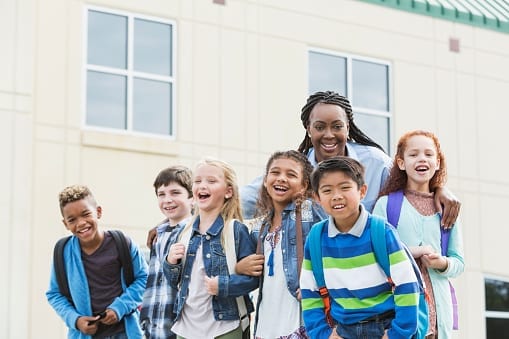
What’s In Your Trophy Case? Students!
In their first principal interview for the NAESP Center for Innovative Leadership, Andy Jacks and Hamish Brewer talk innovative strategies to create a welcoming school climate with California principal Jessica Gomez.
Topics: Family and Stakeholder Engagement, Principal Leadership, Professional Learning, School Culture and Climate, School Management, Student Engagement
Principals are the ultimate change agents who use innovative strategies to be better leaders for students and schools.
“We’re all facing the same challenges, and together, we can come up with solutions,” says Hamish Brewer, principal of Fred M. Lynn Middle School in Prince William County, Virginia.
This spring, we’re giving a voice to principals across the country through the NAESP Center for Innovative Leadership (CIL) video podcast series. This weekly series—led by CIL fellows Andy Jacks and Brewer—will surface solutions to common challenges and uncover how principals are overcoming obstacles in unique and innovative ways. These solutions will be coming to you straight from the source—real leaders who are doing the real work of school leadership all across the country.
“There’s so much innovation that’s happening all across the country all the time,” says Jacks. “We sort of overthink innovation. We think tech and gadgets and what the latest app is, but principals are game-changers. … We’re constantly restructuring, rethinking, and redoing, and that’s all innovation.”
In their first principal interview for the CIL, Jacks and Brewer talk innovative strategies for a welcoming school climate with California principal Jessica Gomez.
The Challenge:
Principal Spotlight:
Jessica Gomez
Principal, Alice Birney Elementary School in Colton, California
Twitter: @Jgomezprincipal and
@birney_cjusd
Insta: principal_gomezA veteran principal, Gomez has led Alice Birney Elementary School—named after a cofounder of the National Parent-Teacher Association—in Colton, California, for the past 10 years. The school serves 680 students: 100 percent of the students receive reduced-price lunch; 95 percent are Hispanic; and 50 percent are English Language learners.
How do I leverage unused space to celebrate students and encourage a culture of literacy?
In this video, Gomez walks you through the halls of her school to show-and-tell how she’s maximized the unused space in her school—and even outside of it. From Gomez, you will learn ideas to:
Leverage unused spaces in the school.
- Gomez did something that most people don’t do anymore—she actually had black-and-white prints made of the photos of her students and staff that lived on her phone and in her social media. After framing them, she displayed them in the lobby trophy case, which turned out to be something she finds students and families alike appreciate.
- When Gomez started at Alice Birney, her hallways were bare—but not for long. She set out to get some color onto the walls and make it about the students. She put up a bulletin board for every class grade and the counselor, and every month, they get updated with items that reflect what they’ve learned over the past month.
Build capacity with staff and motivate teachers.
- To support teachers, Gomez makes sure her staff know she trusts them to do what’s best for the students. On any given day, she can be found in classrooms, taking part in collaborative discussions that help her understand just how much work teachers are putting into everything it takes to run a successful classroom and school.
- Gomez believes that it’s as important for adult learning to be fun as it is for students. Leading up to testing, Gomez motivated her staff by setting up a sports-themed meeting, where staff could play games together before getting down to business.
Collaborate with business partners.
- Before Gomez took the helm at Alice Birney, the school had created a butterfly garden outside in memory of a staff member who passed away. Over the years, the use of the garden and the care of it lessened. That’s where the city mayor and Walmart came in. Together, the managers of the new distribution center revitalized the butterfly garden as a team-building project.
Aha moment:
Gomez knows that she’s built a strong enough relationship with students when they feel that they can come to her.
“We acknowledge you, we love you, we appreciate you,” said Gomez. “We try to do that in so many different ways. Because we want our kids to come to a place where they feel safe, where they feel loved, where they feel supported, and [where] they have an adult they can go to at any time to share what’s on their mind.”
Three main takeaways:
- Trust your staff;
- Join your staff in the trenches;
- Remember what it feels like in the classroom.
Share your strategy: How have you transformed a school space to celebrate students? Go to the NAESP CIL webpage to tell us—and you could be one of the next principals we profile.

